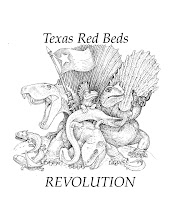Museum expeditions have targeted the largest Dimetrodon cemetery in the world, a bone-bed near Seymour, TX. The teachers have already located six skeletons of the largest Dimetrodon species, as well as babies and teenage Finbacks, representing an entire growth series.

Participants use crime-scene clues to figure out who ate whom 290 million years ago. After four trips in 2006, under the direction of Dr. Bob Bakker and David Temple, teachers have already scored key clues - including a fossil rarity that flummoxed the PhD’s.
The Teachers' Expeditions are employing modern techniques to answer the questions:
To find the answers, teachers map each bone bit found in three dimensions. Then rock samples are dissolved and put through fine mesh screens to check for even tinier fragments. Especially exciting finds are the “fossilized bullets” – or teeth shed by Dimetrodon while it was feeding. The dental “ballistics” show where Dimetrodon was feeding and who its victims were.
Lauletta Bowen holds her Secodontosaurus find.
On another recent trip, teacher David Henderson discovered a fossilized Dimetrodon hip that Dr. Bakker believes to be larger and in better shape than the one on display at the Smithsonian. This teacher's find is currently on display at The Houston Museum of Natural Science.

David Henderson with hip fossil, as it was found.
Dr. Bakker is overjoyed with the results so far. “The teachers are GREAT! They spend ten hours a day down in the red dust, scraping the ancient soil spoonful by spoonful. And they’ve gotten lots of chewed-up victim carcasses….with Dimetrodon bullets! At last we have hard CSI data for the Red Beds.”


2 comments:
I wish Nancy & I were there. Watch out for the scolopendra!
Pat's right. I sure wish I could be there! Happy digging and save some for me.
Post a Comment